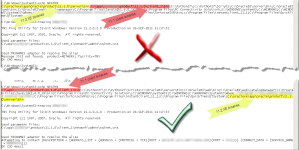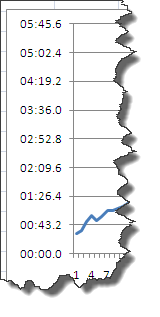I noticed in Ed Stevens’ blog posting here that some sourcecode he’d posted had certain lines highlighted.
WordPress provides the sourcecode tag for marking up sourcecode in blog posts.
For example:
cd /some/random/folder
ls -l
# do not run this next line!
is much better presented as:
cd /some/random/folder ls -l # do not run this next line!
by wrapping it in [sourcecode] tags
I’ve known about the language=’xx’ attribute that you can use with the tag, but Ed’s posting prompted me to check on the syntax and it turns out there a few tweaks one can use. Some of them are illustrated below. The list is taken from WordPress’ Posting Source Code reference page.
[sourcecode] …. [/sourcecode]
#REF: http://en.support.wordpress.com/code/posting-source-code/ # # This is some dummy source code to illustrate sourcecode posting on wordpress # Line 2 # Line 3 cd /some/random/folder ls -l # do not run this next line! rm -rf /some
[sourcecode language=bash] …. [/sourcecode]
#REF: http://en.support.wordpress.com/code/posting-source-code/ # # This is some dummy source code to illustrate sourcecode posting on wordpress # Line 2 # Line 3 cd /some/random/folder ls -l # do not run this next line! rm -rf /some
[sourcecode gutter=false] …. [/sourcecode]
#REF: http://en.support.wordpress.com/code/posting-source-code/ # # This is some dummy source code to illustrate sourcecode posting on wordpress # Line 2 # Line 3 cd /some/random/folder ls -l # do not run this next line! rm -rf /some
[sourcecode collapse=true] …. [/sourcecode]
#REF: http://en.support.wordpress.com/code/posting-source-code/ # # This is some dummy source code to illustrate sourcecode posting on wordpress # Line 2 # Line 3 cd /some/random/folder ls -l # do not run this next line! rm -rf /some
[sourcecode highlight=3,5,6,8] …. [/sourcecode]
#REF: http://en.support.wordpress.com/code/posting-source-code/ # # This is some dummy source code to illustrate sourcecode posting on wordpress # Line 2 # Line 3 cd /some/random/folder ls -l # do not run this next line! rm -rf /some
[sourcecode firstline=42] …. [/sourcecode]
#REF: http://en.support.wordpress.com/code/posting-source-code/ # # This is some dummy source code to illustrate sourcecode posting on wordpress # Line 2 # Line 3 cd /some/random/folder ls -l # do not run this next line! rm -rf /some
[sourcecode padlinenumbers=3] …. [/sourcecode]
#REF: http://en.support.wordpress.com/code/posting-source-code/ # # This is some dummy source code to illustrate sourcecode posting on wordpress # Line 2 # Line 3 cd /some/random/folder ls -l # do not run this next line! rm -rf /some
[sourcecode toolbar=false] …. [/sourcecode]
#REF: http://en.support.wordpress.com/code/posting-source-code/ # # This is some dummy source code to illustrate sourcecode posting on wordpress # Line 2 # Line 3 cd /some/random/folder ls -l # do not run this next line! rm -rf /some
[sourcecode light=true language=’bash’] …. [/sourcecode]
#REF: http://en.support.wordpress.com/code/posting-source-code/ # # This is some dummy source code to illustrate sourcecode posting on wordpress # Line 2 # Line 3 cd /some/random/folder ls -l # do not run this next line! rm -rf /some




